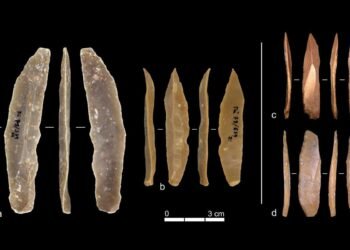During a routine measurement in the Trave River, the Kiel-Holtenau Waterways and Shipping Authority made an intriguing discovery—a ship submerged at a depth of eleven meters.

A team of researchers from Kiel University conducted an eight-month examination of the ship, revealing that it was a nearly 400-year-old vessel from the Hanseatic period, an uncommon find in the western Baltic region. The remnants of the ship include wooden beams and a significant portion of its cargo, covered in mussels after centuries in the murky waters of the Trave River.
Dr. Fritz Jürgens from Kiel University’s Institute of Prehistoric and Protohistoric Archaeology confirmed through independent dating that the ship dates back to the mid-17th century.
The discovery left Jürgens and his team astounded and described it as a truly unique find. Further investigations were conducted by researchers from the Hanseatic City of Lübeck and the University of Göttingen, who joined Jürgens in examining the ship’s remains.
The cargo on board was identified as lime by Kiel University’s Institute of Geosciences. The ship was likely transporting quicklime, a popular building ingredient during that period. Lime was produced by quarrying limestone, burning it, and extinguishing it, ultimately transforming it into mortar.
Initial evidence suggests that the ship was en route from Scandinavia to Lübeck but never reached its destination.
More research is required to determine why the Hanseatic ship sank, although indications point to the possibility of it running aground on a bend in the Trave River, causing severe damage that led to its sinking.
The researchers produced 3D models based on photos and videos, revealing that the original length of the ship was approximately 20-25 meters. This makes it a medium-sized cargo sailing ship, a common vessel used in Baltic Sea trade during that era.
Dr. Fritz Jürgens emphasized the significance of the find for the western Baltic Sea region, as wrecks of a similar nature have typically been discovered in the eastern Baltic Sea region.
The dives conducted by the researchers exposed the vulnerability of the wreck to erosion and shipworm infestation. Without protective measures, the wreck would deteriorate within a few years, resulting in the loss of evidence pertaining to the extensive maritime trade of the Hanseatic City of Lübeck.
To prevent this, Kiel University researchers, in collaboration with the City of Lübeck and other institutions, are developing a strategy for the preservation and protection of the wreck, including the possibility of salvage.
The discovery process began in February 2020 when the Kiel-Holtenau Waterways and Shipping Authority noticed an anomaly in the multibeam echosounder results during a routine examination of the Trave River’s navigable channels. Divers investigated the site in August 2021 to ensure the safety of passing ships and detected initial signs of a wreck.
The Hanseatic City of Lübeck’s upper historic monument protection authority commissioned Kiel University to conduct further research on the wreck. In November 2021, the researchers commenced their work with the support of the Forschungstauchzentrum (scientific diving center) and the Lübeck Port Authority.
They were later joined by scientific diver Christian Howe, an experienced underwater photographer and cameraman. Thirteen dives totaling 464 minutes provided the archaeologists with ample material for their initial comprehensive report.






















